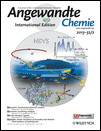Inside Back Cover: Direct Prediction of NMR Residual Dipolar Couplings from the Primary Sequence of Unfolded Proteins (Angew. Chem. Int. Ed. 2/2013)
Graphical Abstract
NMR spectroscopy is a powerful method for studying disordered proteins, providing atomic resolution and ensemble-averaged information. In their Communication on page 687 ff., M. Blackledge et al. show that by analyzing local and long-range effects, residual dipolar couplings can be determined up to six orders of magnitude faster than by existing techniques.





